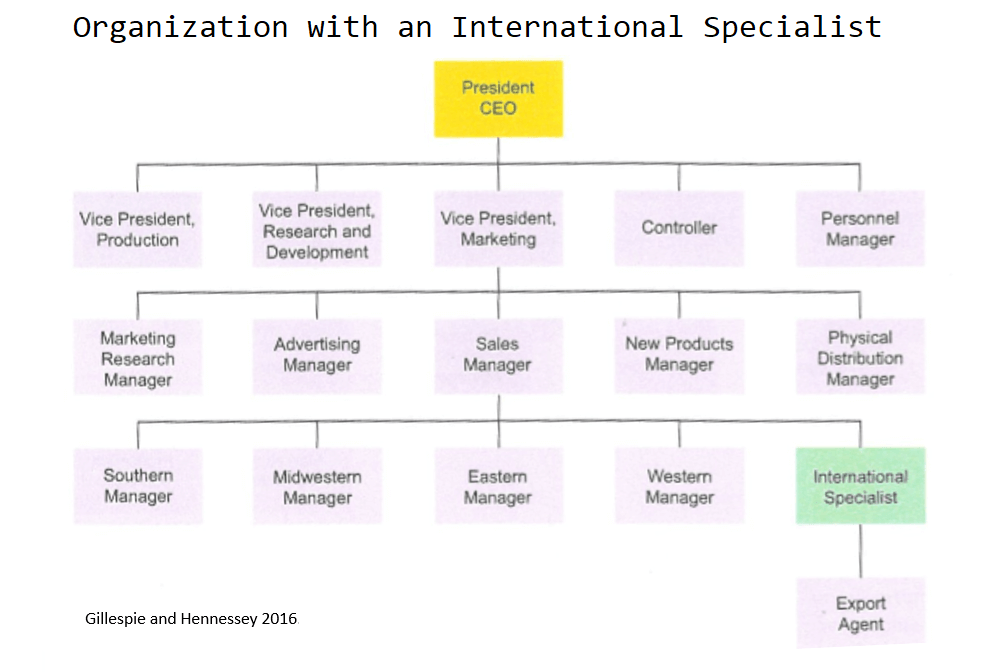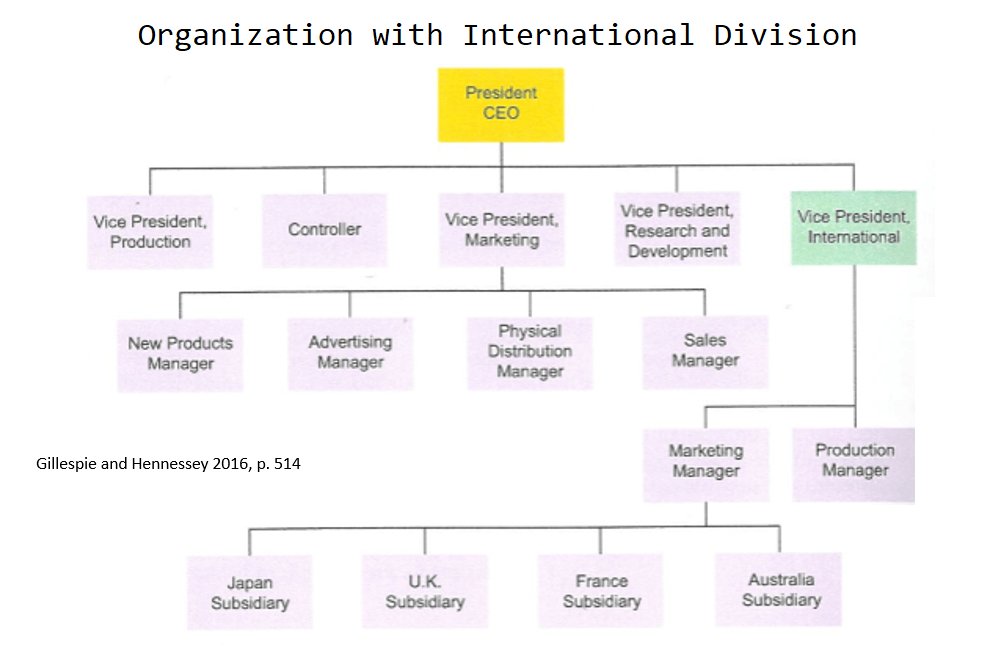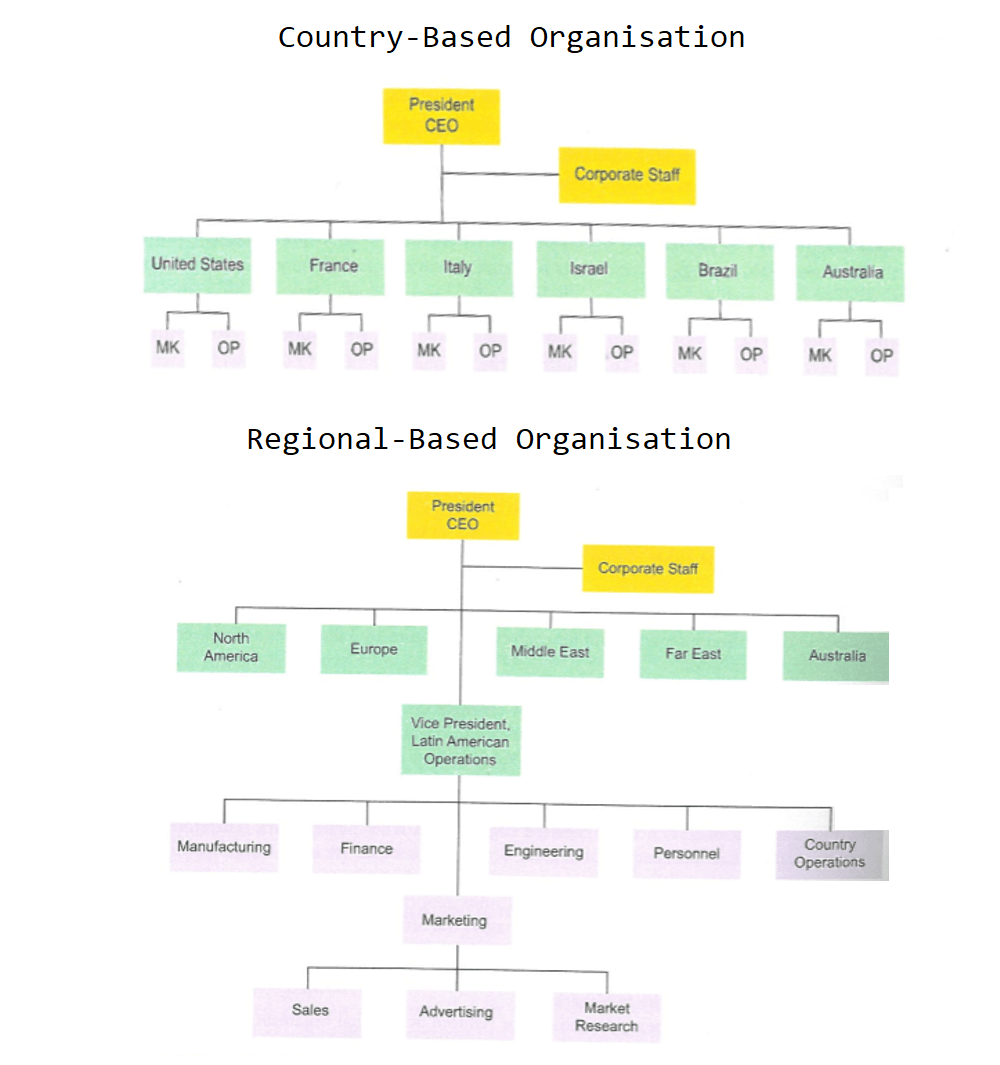
The success of a global strategy is influenced by the selection of an appropriate organizational structure to implement that strategy.
The ideal structure of such as an organization should be a function of:
- the products and services to be sold in a marketplace
- the external and internal environment
Theoretically, the way to develop a global marketing organization is to analyse the specific tasks to be accomplished within an environment and then to design a structure that will support these tasks most effectively.
However, practically, a number of factors complicate the selection of an appropriate organization, such as:
- Already existing organizational structure
- The internal and external environments continuously change
Related: Types of Organizational Structures
Organization with an International Specialist
The complexities of selling a product to a variety of different countries prompt firms to establish some international expertise.

This expertise can range from employing a part-time international specialist to having a full-time specialists organized into an export department.
International specialist or export departments primarily perform sales functions such as:
- respond to inquiries
- manage exhibits at international trade shows
- handle export documentation
- deal with shipping, insurance, and financial matters.
International specialists may also maintain contact with embassies, export financing agencies and various departments of commerce.
Organization with an International Division
As sales to foreign markets become more important and the complexity of coordinating the international effort extends beyond the capacity of a specialist or an export department the firm may establish an international division
.
The international division normally reports to the president of the firm. This gives it equal status with other divisions such as marketing, finance, and production.
International divisions are directly involved in the development and implementation of a global strategy. These divisions focus all their efforts on international markets.
Geographic Organizational Structures
The geographic organizational design is appropriate when the company needs an intimate knowledge of its customers and their environments.

Such a design gives the company the opportunity to understand the local culture, economy, politics, laws and competitive situation.
Geographic structures can be either regionally-focused and country-based structures.
A country-based organization focuses on individual countries rather than on a group of countries. For example, instead of having a regional management centre in Brussels overseeing all European sales and operations, the company has an organizational unit in each country.
The country-based organization can be extremely sensitive to local customs, laws, and needs all of which can differ considerably.
Regional management centres enable an organization to focus on particular regions of the world such as Europe, the Middle East, Latin America, North America.The reasons for using a regional approach to organizational design are related to market similarity and size.
A group of countries that are located close together and have similar social and cultural histories, climates, resources, and sometimes languages may have many similar needs for products.
Factors affecting Organizational Structure
Internal Elements that Affect Structure
Internal elements that affect how global organizations are structured and managed: Human Resources, Flexibility, Importance of International Sales, Diversity of International Markets Served, Importance of International Sales, Corporate Worldview, Level of Economic Commitment.
Importance of International Sales
The size and importance of a firm’s international business affects its organizational structure.
If only a small percentage of sales (1 to 10 percent) is international, a company will tend to have a simple organization such as an export department.
As international sales increases relative to total sales, a company evolves from having an export department to having an international division and then to having a worldwide organization.
Companies may even consider moving global headquarters out of the home country as overseas sales become increasingly important.
Corporate Goals
Every company should have a mission. The mission statement is the glue that holds the company together.
Reconsidering a firms mission can result in organizational change. When Bayer introduced a new mission statement emphasizing innovation and sustained growth, the company also announced a structural realignment to better attain these goals.
Other Internal Factors
- Diversity of International Markets Served: As the number and diversity of international markets increase, it becomes necessary to have a more complex organization to manage the marketing efforts.
- Level of Economic Commitment: A company that is unwilling or unable to allocate adequate financial resources to its international efforts will not be able to sustain a complex or costly international structure.
- Human Resources: A lack of appropriate personnel can constrain a firm’s organizational growth. Some companies send top domestic executives to foreign operations only to find that these expatriates do not understand the nation’s culture. The hiring of local executives is also difficult because competition for such people can be extremely intense.
- Flexibility: The structure must be flexible enough to respond to the needs of consumers and the challenges of competition
External Elements that Affect Structure
External Elements that affect how Global Organizations are structured and managed: Geographic Distance, Government Regulations, Types of Customers, Time Zone Differences.
Geographic Distance:
Technologies allow companies conveniences such as next-day mail and email, video-conferences, mobile phones, mobile data, rapid transportation and, of course, the Internet.
But the distances are still relevant, in particular, where the telecommunication infrastructure may be less available. Organizations in the same region are often grouped together to help minimize travel costs and the travel time of senior executives.
Government Regulations
How various countries attract or discourage foreign operations can affect the structure of the global organization.
Laws involving imports, exports, taxes, or hiring differ from country to country. Local taxes, statutory holidays, and political risk can deter a company from establishing a subsidiary or management centre in a country.
Time Zones:
One problem even high technology cannot solve is time difference.
Managers in New York who reach an agreement over lunch will have a hard time finalizing the deal with their headquarters in London until the following day, because by that time most executives in London finish work and go home.
The time difference results in lost communications time and impedes rapid results. Different times zones make companies open offices around the world.
Types of Customers
- Number, geographic concentration, global/local segmentation of consumers will influence the organization of global marketing efforts.
- If a firm has key global customers, it may organize and select its office locations according to where its customers are located.
- If a firm sells to large numbers of customers, it tends to maintain regional or even country specific organizations with relatively less centralizations.
- If customer needs or competition varies greatly from country to country there is also less motivation to centralize.
References
Gillespie K. & Hennessey H. D. (2016). Global marketing
BATheories.com is managed by a group of educators from Mumbai. We also manage the website AcademicsHQ.com. Our panel includes experienced professionals and lecturers with a background in management. BATheories is where we talk about the various business theories and models for BA (Business Administration) students.